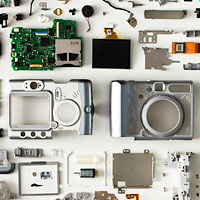When the camera you buy isn’t the camera you get: the highs and lows of firmware updates
posted Monday, December 23, 2013 at 6:10 PM EST

With Christmas just a few days away, and other holidays having just been, doubtless many of our readers will soon be receiving -- or have just received -- some shiny new toys. And as devoted readers of our Firmware Friday posts will attest, it doesn't take long for manufacturers to start rolling out updates and tweaks for their gear. But which camera makers can you rely on to bring everything from minor fixes to major new features? And which ones will leave you with your camera as it is, warts and all?
When it comes down to it, the king of firmware is doubtless Fujifilm, which has gone above and beyond when it comes to supporting the flagship X-series of cameras. The Fujifilm X100, X100s, X-Pro1, X-E1, and many others have all received bountiful updates over the years. The most significant of these is the X-Pro1, which is now up to v3.10 of its firmware. Fujifilm has made a number of major changes to the X-Pro1, including improvements to autofocus speed, manual focusing, operational speed, and viewfinder performance. The company has even rolled out a new focus peaking feature. And this is amidst countless other tweaks, like lens specific enhancements, handling changes, and a great number of other additions. It's an incredible commitment from Fujifilm, and one that other manufacturers would do well to emulate.
If you own one of its high-end cameras, Canon also has your back, but less so if you're shooting an entry-level model. It seems like Canon cameras are in just about every Firmware Friday column we publish, though. The company updated the 7D to significantly improve the maximum number of images in a raw burst, as well as to tweak the AF. The Canon 5D Mark III got uncompressed HDMI video output. The 1D-series have had a number of updates, and the C-series camcorders received a major ISO boost. Canon is even able to add phase-detection autofocus to the C100, if you're willing to pay for it. But these are all high-end, expensive cameras from Canon, you don't generally see similar improvements for the Rebel line. The one notable exception to that was when Canon tweaked the AF speed on the EOS M, which brought it from very slow to just middle of the road.
Sony hasn't been quite as prolific with its updates, but does offer some pretty big improvements every now and then. When the NEX-line first debuted, Sony significantly tweaked layout customizability, as well as compatibility with lenses via adapters. More recently, we've seen some minor tweaks, and some significant lens-related improvements. Sony's Alpha DSLRs have also received some love, with firmware improvements to handling and autofocus. The most interesting of Sony's recent offerings is for the QX10 and QX100, which promises to bring faster connection times, as well as better video modes and a wider ISO range. The QX100 is also set to get shutter priority shooting, which it sadly lacked before.
Panasonic is somewhere in the middle of the road. On the plus side, the GH3 got faster shooting (more than once even), and there were some minor updates for the GX7. The company has also offered some updates for its compact cameras as well. But it's not all rosy: while a number of Panasonic's mirrorless cameras have focus peaking, it was never brought to the GH3 -- despite Panasonic suggesting that it might be possible. Of course, this could be due to a limitation of the camera's hardware -- focus peaking places very particular demands on a camera's image processing chain.
Who else does that leave? Olympus' updates seem to be on the minor side, with few major new features in the running. Pentax offers the occasional update, though they, too, primarily seem to be bug fixes. Ricoh does a good job with adding features and improving its cameras, as you can see with the recent Ricoh GR updates, but they aren't yet a major force in the US market. And then there's Nikon, who seem to constantly be pushing out updates -- but with the exception of some recent 1-series updates, they're largely confined to small changes and bug fixes.
Of course, all of these updates' significance relies on people actually installing the firmware on their camera. And given how dry firmware updates tend to be, we're willing to bet that most people never even knew there were firmware updates out there for their cameras — let alone installed them.
But the long and the short of it is this: if you bought a Fujifilm X-series camera, you can rest assured that you'll probably see some updates in the future. Canon and Sony users can also feel some assurance. Everyone else will just have to wait and see.
(Camera parts image courtesy of Kelly Hofer / Flickr; used under a Creative Commons CC-BY-2.0 license.)